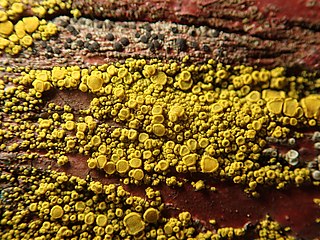
The Arthoniales is the second largest order of mainly crustose lichens, but fruticose lichens are present as well. The order contains around 1500 species, while the largest order with lichenized fungi, the Lecanorales, contains more than 14000 species.

The Gomphillaceae are a family of lichen-forming fungi in the order Graphidales. Species in this family are found mostly in tropical regions.

The Graphidaceae are a family of lichen-forming fungi in the order Graphidales. The family contains nearly a hundred genera and more than 2000 species. Although the family has a cosmopolitan distribution, most Graphidaceae species occur in tropical regions, and typically grow on bark.

Fissurina is a genus of lichenized fungi in the family Graphidaceae. It has about 160 species, most of which are found in tropical regions.
Fibrillithecis is a genus of lichen-forming fungi in the family Graphidaceae. The genus was circumscribed in 2006 by the German lichenologist Andreas Frisch, with Fibrillithecis vernicosa assigned as the type species.
Badimia is a genus of foliicolous (leaf-inhabiting) lichens in the family Ramalinaceae.
Bogoriella is a genus of crustose lichens in the family Trypetheliaceae.

The Trypetheliaceae are a family of mainly lichen-forming fungi in the order Trypetheliales. The family consists almost exclusively of corticolous (bark-dwelling), crustose lichens with an almost strictly tropical distribution.
Oevstedalia is a genus of fungi of uncertain placement in the subphylum Pezizomycotina. This is a monotypic genus, containing the single lichen species Oevstedalia antarctica. The genus was circumscribed by Damien Ertz and Paul Diederich in 2004. Previously classified in the Dothideomycetes, Oevstedalia was moved to Pezizomycotina incertae sedis due to the lack of DNA data available for the genus.

Candelariaceae is a family of lichen-forming fungi in the order Candelariales. It contains seven genera and about 73 species.

Candelariella is a genus of bright yellow, ocher, or greenish yellow crustose or squamulose lichens in the family Candelariaceae. Members of the genus are commonly called eggyolk lichens, goldspeck lichens, or yolk lichens. The genus was circumscribed in 1894 by Swiss lichenologist Johannes Müller Argoviensis, with Candelariella vitellina assigned as the type species.

Sporastatia is a genus of crustose lichens in the family Sporastatiaceae. It has four species. Sporastatia lichens are long-lived species that grow on siliceous or weakly calcareous rocks in arctic and alpine locales.
Xenus lithophylli is a species of lichenized ascomycete fungus discovered in 1992, composing the entire monotypic genus Xenus. It is found parasiting the calcified algae Lithophyllum, and lives attached to corals in Belize, in the Caribbean.
Moriola is a poorly-known genus of fungi in the family Verrucariaceae. It has 17 species. Members of the genus parasitise various algal species; some species are considered to be saprotrophic or "doubtfully lichenized".
Strangospora is a genus of lichen-forming fungi. It is the only genus in the family Strangosporaceae, which itself is of uncertain taxonomic placement in the Ascomycota. It contains 10 species.
Helocarpaceae is a family of lichen-forming fungi in the subclass Lecanoromycetidae. The family is monotypic, and contains the single genus Helocarpon.
Elenkiniana is a genus of lichen-forming fungi in the family Teloschistaceae. It has three species, all of which occur in Eurasia.
Phyllobathelium is a genus of lichen-forming fungi in the family Strigulaceae. It comprises eight species of foliicolous (leaf-dwelling, crustose lichens.
Haploloma is a fungal genus of unknown familial and ordinal placement in the class Lecanoromycetes. It contains the single species Haploloma fraudulentum, a lichen.







